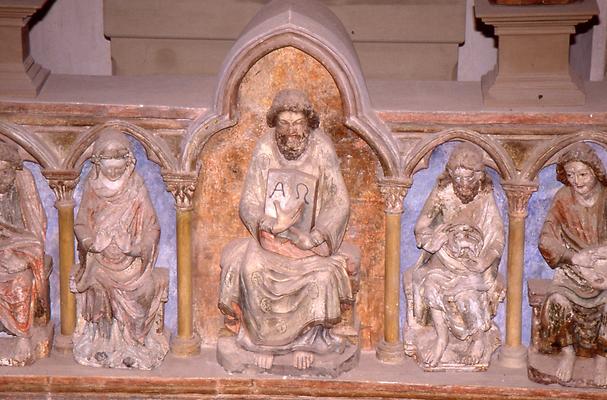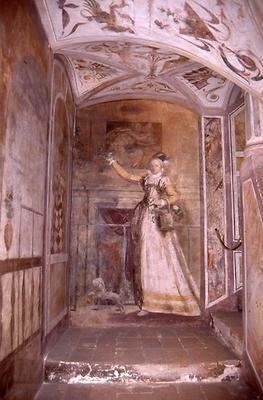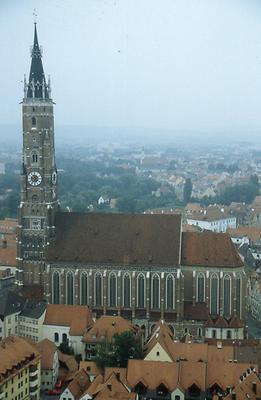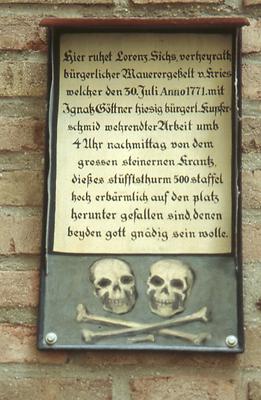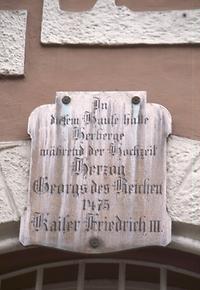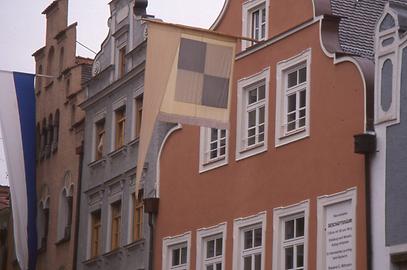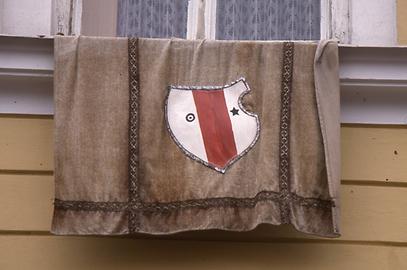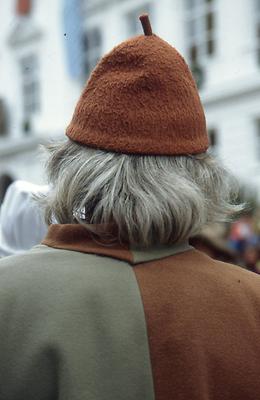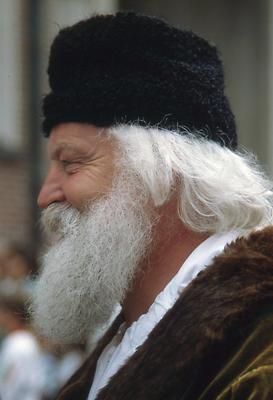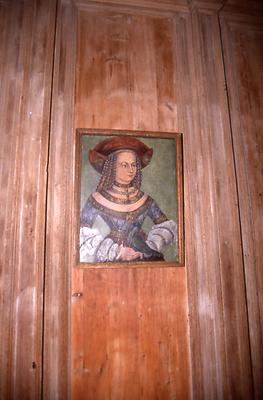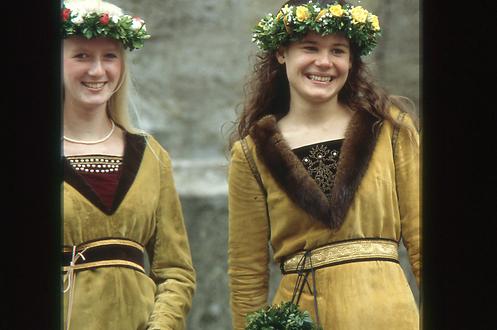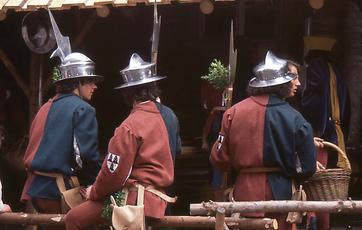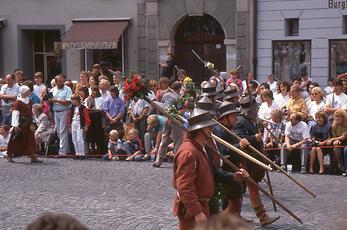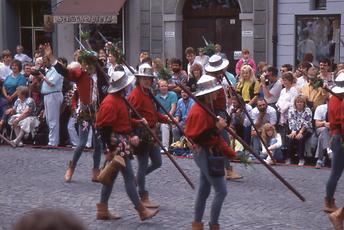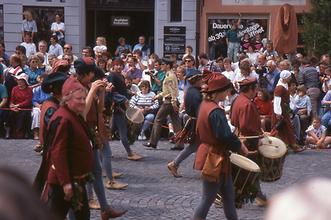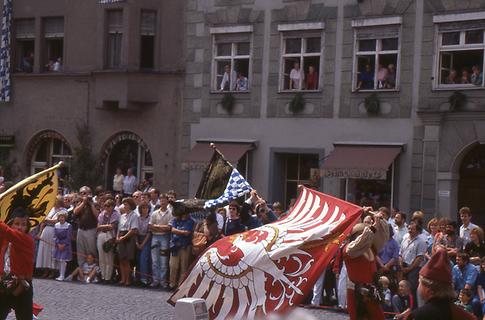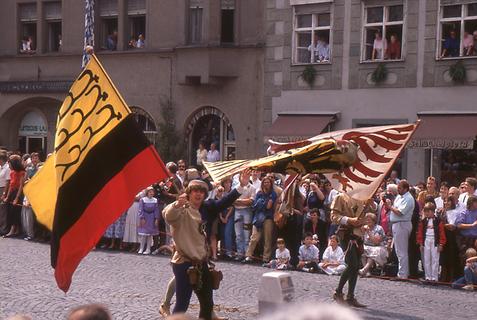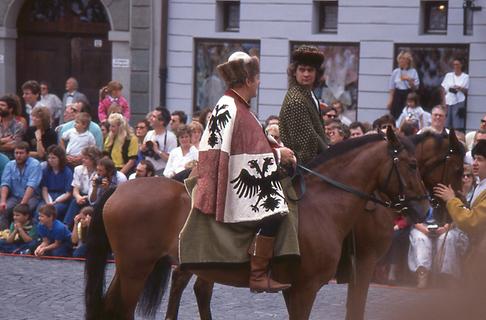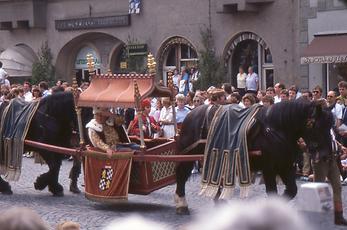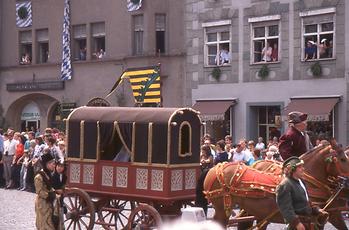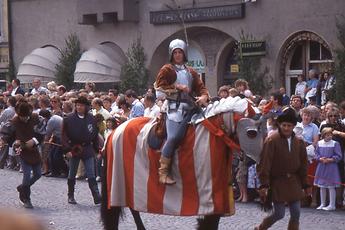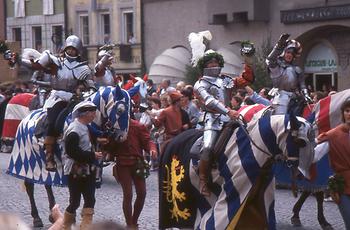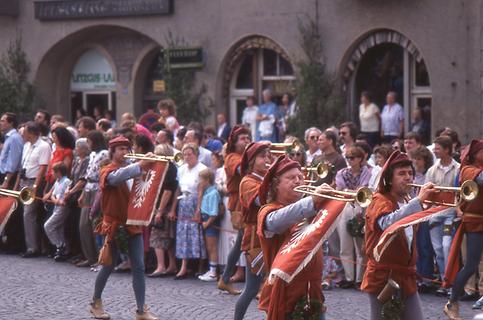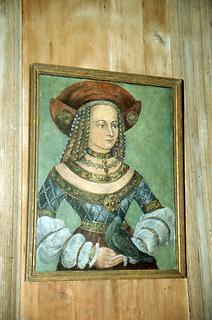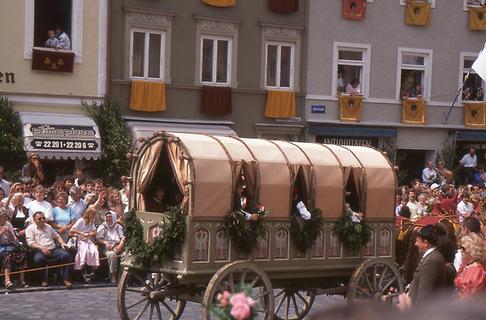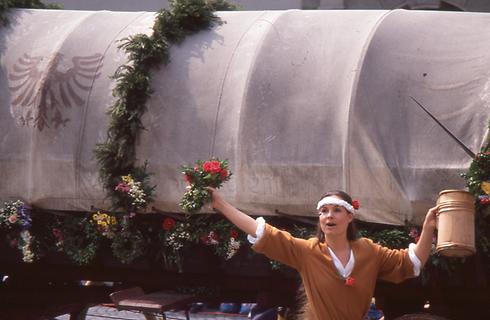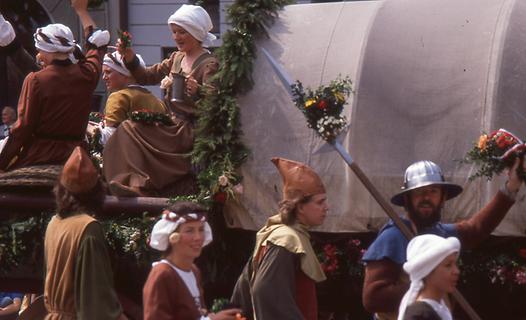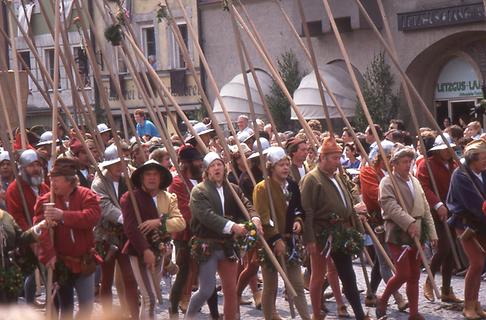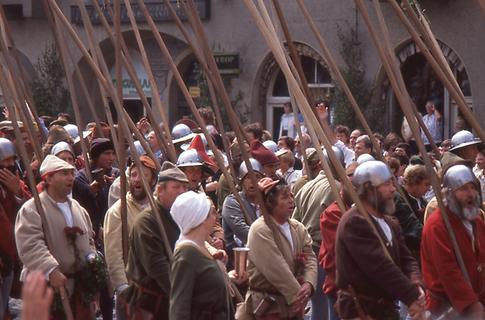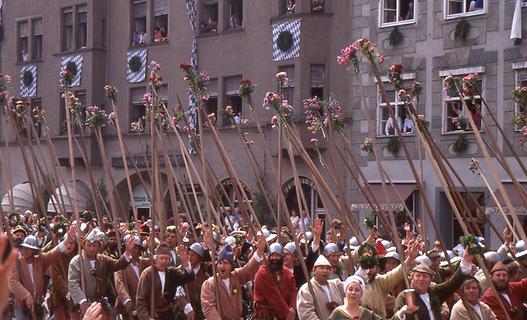Wedding in Landshut#
A whole city plays 'Middle-ages'#
All photos were taken by the author in the years 1988, 1989 and 1993. They are part of his archive "Picture-flood Jontes".
Festivities of any kind since ancient times were elevated by the mobile element of processions to make excited people aware of power and generosity and warn them of what power is capable of doing for better or for worse. The most spectacular were the military triumph marches in ancient Rome.
The Trionfi of the Renaissance were of high aesthetic quality. In Florence of the Medici, crowds of artists endeavoured to present the economic and cultural decorum of the rulers in the proper light.
The nineteenth and early twentieth century advanced gigantic processions, for example, the story of a dynasty in historically approximately correct costumes. This was twice the case in Vienna. Historical processions, each lasting one hour, passed through the capital and residence on the occasion of the silver wedding of the imperial couple Franz Joseph and Elisabeth in 1879 and the 60th anniversary of Franz Joseph's reign in 1908.
This particular kind of propaganda became gradually less important. War and other times of distress were no longer a source of festivals. Many decades have passed since the last manifestations of public representation.
Today, more or less miserable attempts are being made in which Roman legionaries, bullhorn-helmeted Vikings, Celtic druids, or metal knights participate especially in local celebrations and anniversaries of associations. The historic features have given way to a new, stable form. At medieval feasts with ridden tournaments and old craftsmanship, and meals which are eaten with the hands, the astonished visitors take everything they see as historically true.
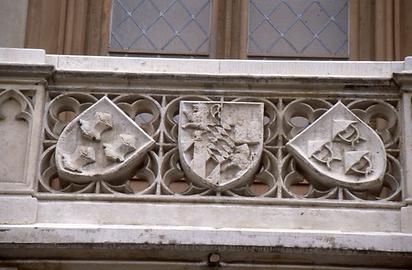
However, in Bavaria, there is a city that has celebrated a medieval spectacle for more than a hundred years in a historically form close to perfection. This is one of the most important historical festivals of the German Middle Ages. It is the city of Landshut and the wedding of 1475, when the son of Wittelsbach's Duke Ludwig, George the Rich, married the Polish Princess Jadwiga (Hedwig) Jagiellonica, daughter of King Casimir IV Jagiello.
Landshut, the seat of government of Niederbayern, has about 70,000 inhabitants who are aware of their great historical past. It was first mentioned in 1150. The settlement which is located at important trade routes was given the title of City in 1204. Due to its strategical importance it was the main city of the House of Wittelsbach until 1253. The name indicates the strategical function. „Hut“ has the meaning protection of the country. Typically, the original coat of arms of the city bear in silver three, two to one placed, blue iron hats in silver with entwined red storm straps.
Above the town lies the mighty castle Trausnitz. It was the starting point of a growing village, which later grew into the town of Landshut as a castle settlement. It is still today a splendid example of a medieval fortress. Its its premises are also included in many events of the Landshut Wedding.
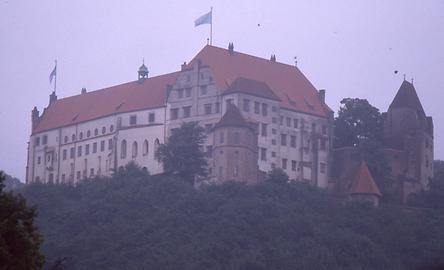
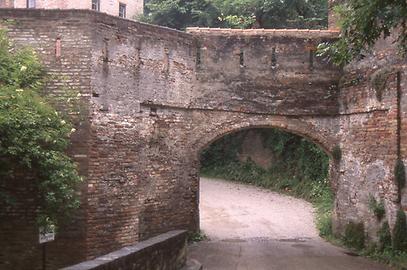

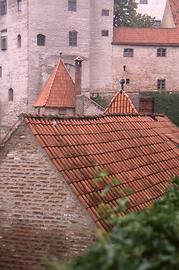
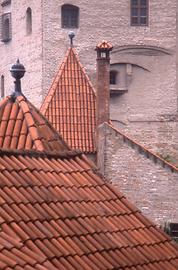

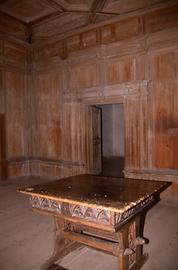

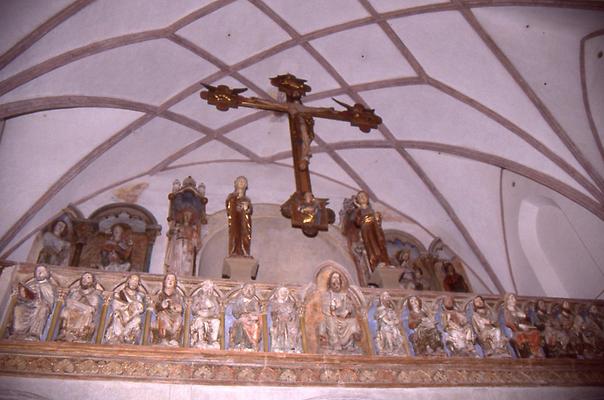
The gallery of the castle chapel was reserved for the castle owner and his family. All others had to make do with the ground floor.
In the Renaissance, some figures were painted on the wall as eye-deceiving gimmicks, with a realism good enough to frighten a careless person.
The city is dominated by several relgion realted buildings, among which the Gothic parish church of St. Martin is particularly prominent. The three-nave hall church has the highest church tower built of bricks of 130.6 meters. It was completed around 1500.
The Gothic vaults had just been finnished in time to avoid the economic and cultural reasons that lead to the end of the Gothic period.

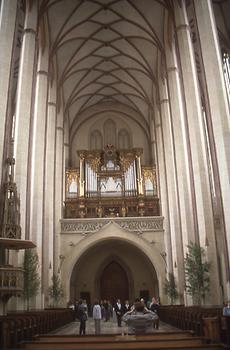
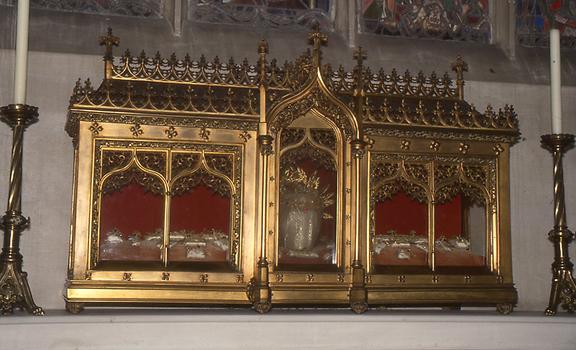
The church of Martin took the relics of St. Castulus from nearby Moosburg. Indulgences related thereto for the own soul and the soul of relatives had a high priority in performance piety of the Late Middle Ages.
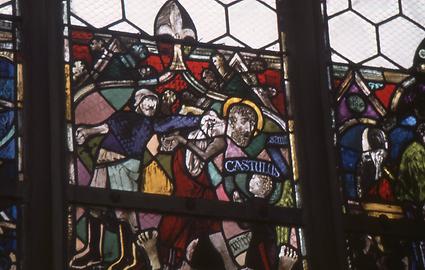

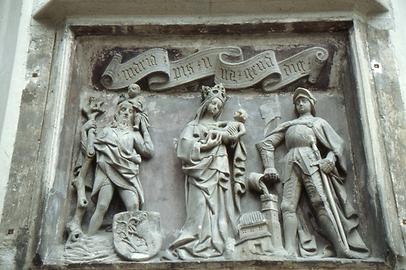


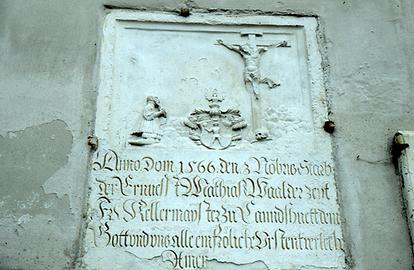
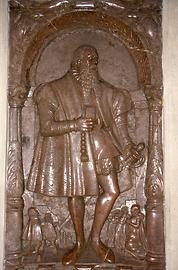
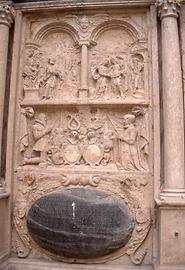

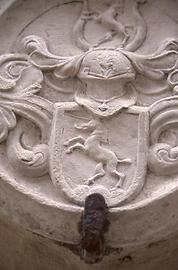


The old town of Landshut has a whole series of stately buildings connected either with political administration or bourgeois prosperity.
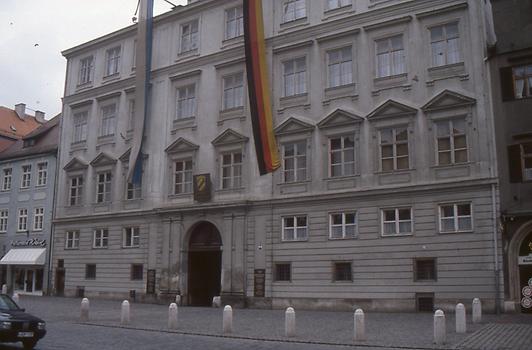
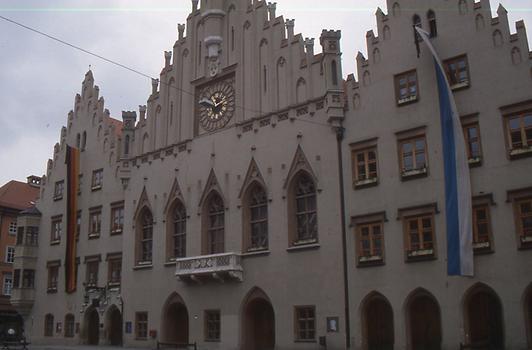


Small references to commercial or historical peculiarities make the townscape attractive in an original way. The city administration takes care of the overall impression of the historic old town. Furthermore Landshut, has largely been spared from the Allied bomber war of the Second World War.
Numerous buildings are adorned with flags During the festival of the Landshut Wedding. The colours of the flags match exactly the possibilities of the Late Middle Ages. Nothing is too colourful because there were only vegetable colours available for dyeing of textiles. In most cases, this applies to clothes, too.
In 1475, two royal houses were closely connected because of political reasons. People were shocked at learning that Constantinople was conquered by the Turks in 1453. There was a strong alliance against the Ottoman Empire. Five years later in 1480, the year of the plagues of God, the Ottoman Turks raged in Styria directly in front of the Bavarian doors. The wedding with its excessive splendour was to indicate that enough funds could be raised to deal militarily with the danger.
The bridal journey from Krakow to Landhut took two months. On the one hand, the streets in this part of the Empire were very bad. On the other hand, the world should see the power behind it. The wedding was celebrated by the Archbishop of Salzburg, Berhard von Rohr, in the main church of St. Martin. There was a pageant to the town hall afterwards where the social part of the event was opened. The highest ranking participant, Emperor Friedrich III, led the new Duchess to the wedding dance. Around ten thousand distinguished guests participated in the multi-day events. But there were also big vats of wine provided for common people, and everybody went home with a loaf of bread.
Nowadays, at the beginning of the spectacle, the streets of Landshut are filled with thousands of visitors who are walking through the city during the day. They admire and enjoy all the attractions that have been re-enacted perfectly from the Middle Ages.


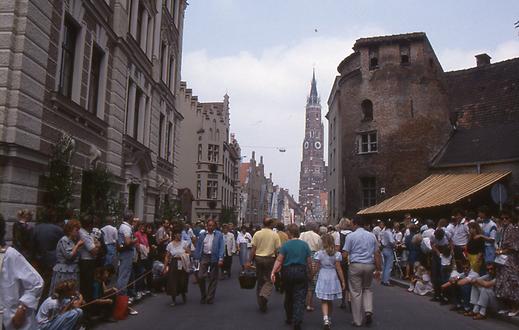
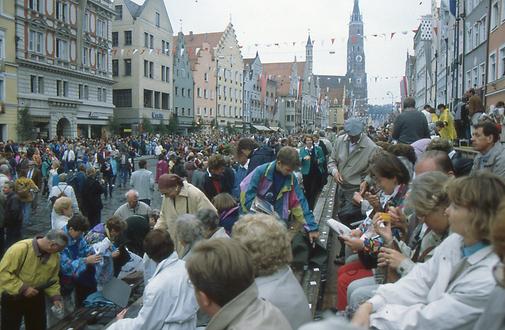

The festival ground or „Zehrplatz“ outside the city is empty during the day. It gets crowded and things get lively when there are tournaments, camp life, disguise, nocturnal games and the festive entry of the princes.

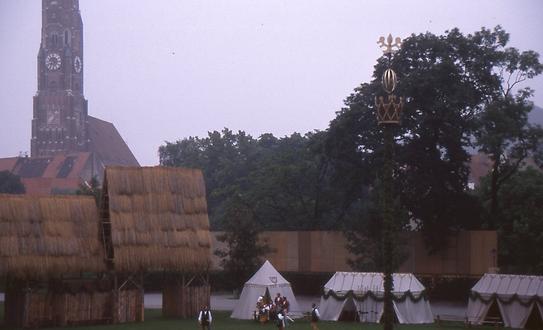

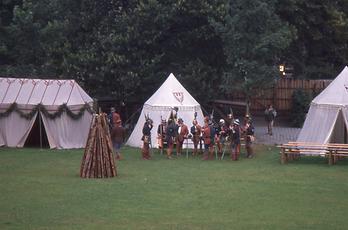
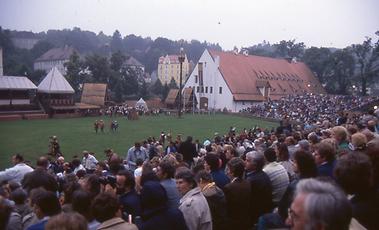
Around 1900 Landhut remembered the historical events four and a half centuries ago and thought of a romantic new production of the wedding. Therefore, an association with teh simple name „Die Förderer“ (The Supporters) was founded. With its currently 7000 members it is still organizing the events after more than one hundred years. In 1903, the wedding event took place with 145 participants clad in medieval ways. Today, there are more than 2000 such participants!
From 1903 to 1914 the big festival took place annually. The First World War interrupted the game, but from 1922 to 1938 the festival took place again on a yearly basis. After the Second World War there was a three-year rhythm and as of 1985 a four-year rhythm. Unfortunately, a part of the historical costumes and props had been destroyed by a fire in the post-war period. Today, the spectacle takes four weekends in the early summer, with the wedding ceremony taking place on Sunday afternoons.
Unbelievable masses of visitors are expected. The city makes available parking spaces for 1500 buses in several parking lots. It is not easy to participate as active member in the wedding. One has to apply in writing that one wants to join „The Supporters“ and is then invited to a rehearsal.
Both sexes have to let their hair grow as it was at the time of the original event. Men must not have modern styled beards.
The body size also plays a role, because costumes are not available for all sizes. The participants are divided into groups according to their abilities. Specialists such as dancers, jugglers, mimes or musicians appear in groups. Bride and groom have to be from Landshut. They are selected from the group of young maidens and junkers who had been at the wedding in the royal household four years ago. The bride should also resemble to some exent the Polish princess who is depicted on a contemporary portrait painting at Trausnitz Castle.
Visitors can walk around in Landshut during the day. Most of the participants have beautiful wreaths on their heads or clothes. The joyous historic greeting HALLOOOOOOOO can be heard all around.
Everywhere participants and visitors mix and there is a joyous and cheerful atmosphere.
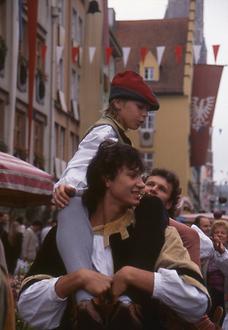
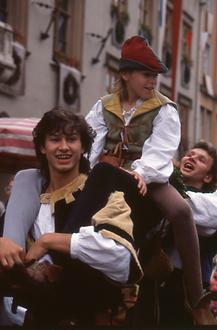

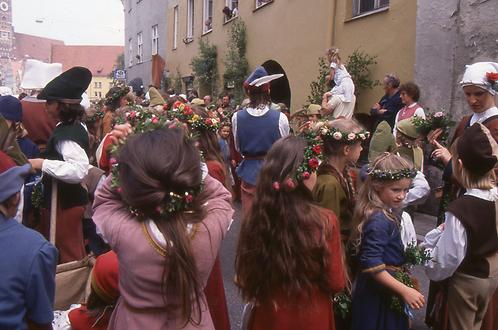
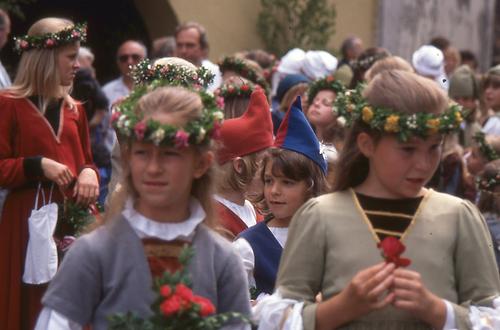

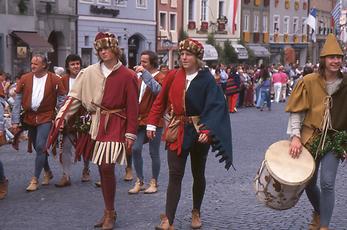
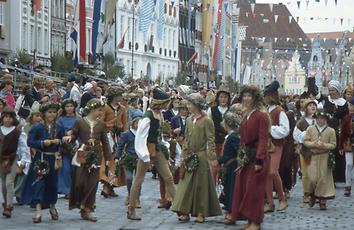
The town guard takes care of peace and order, as it did in the Middle Ages. They are armed with halberds and wear iron balaclava on their head.
The town guards who keep watch at the city gates put the weapons aside and prepare a well-deserved roast on the grill. It happens again and again that if you have some nice and friendly words for them, you get a good bite on the knife point. You should not miss to take a huge drink.
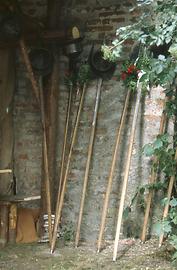
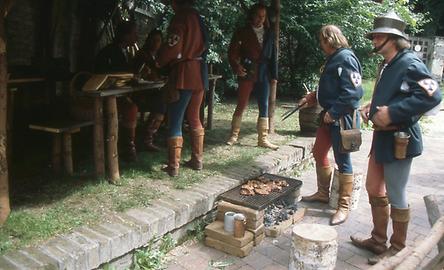
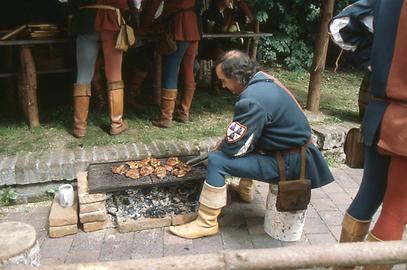
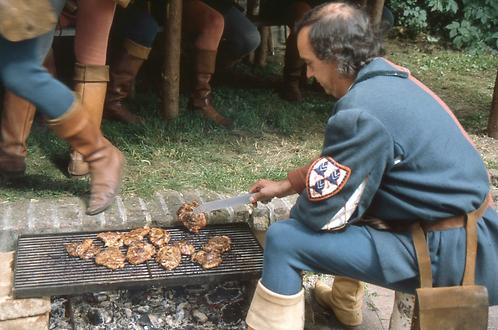
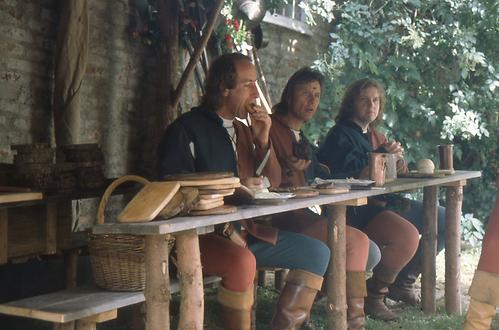
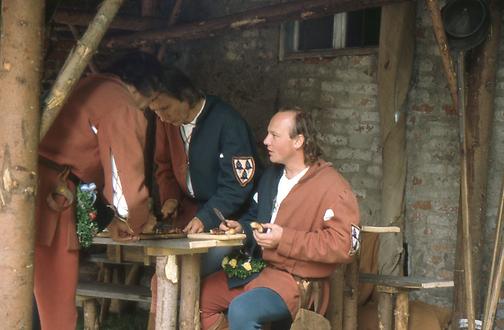
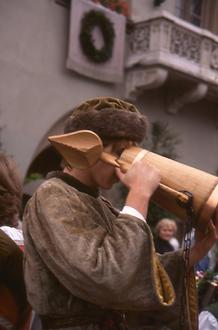
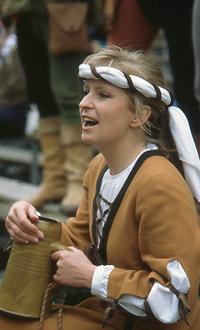
Wine is offered everywhere. In the Middle Ages, wine was not merely a drink, but also food and calorie provider. There are beautiful waitresses encouraging to drink.
Such a day in a festive city offers the possibility to look at the faces, the clothes and head coverings and to admire the sublte colourful textiles.
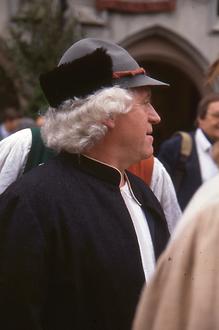

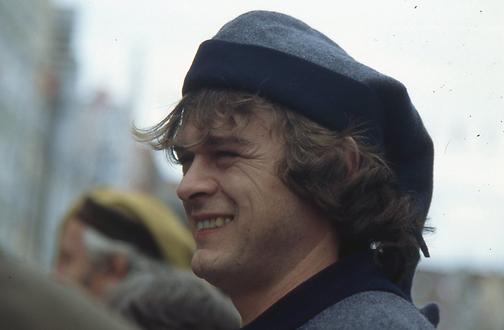

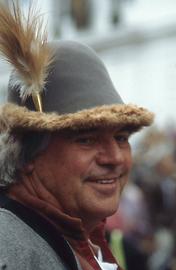
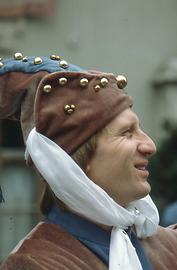

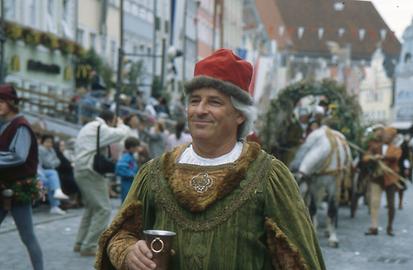
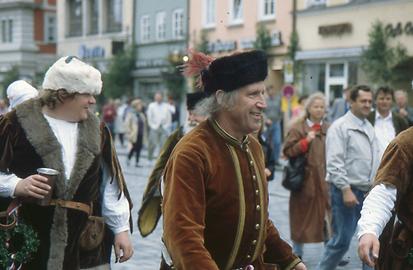

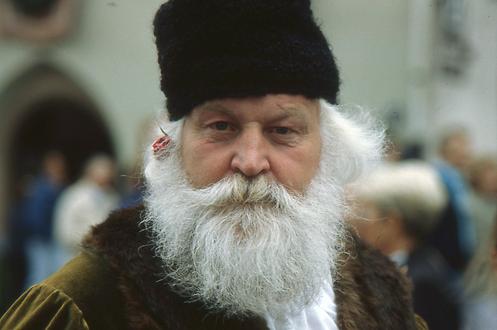
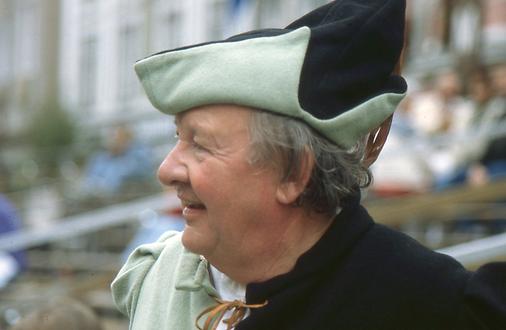
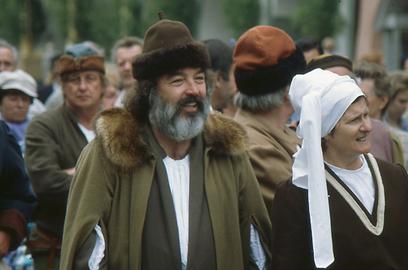
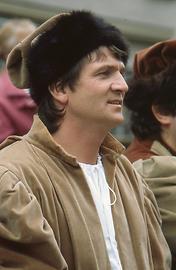
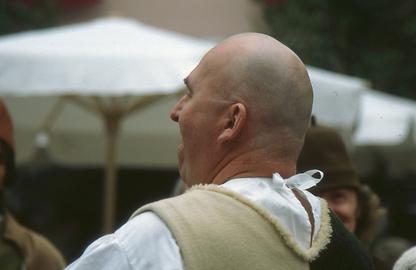

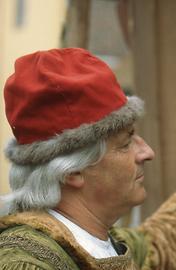
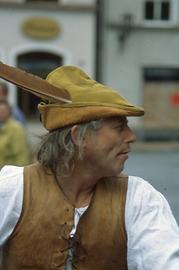

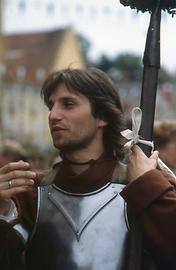
From far away one can hear unusual music and when following it one meets an ensemble of musicians with medieval instruments such as drum, shawm, trumpet, trombone, crumhorn, a tiny little flute, pommer. The musicians are playing popular songs of their time.


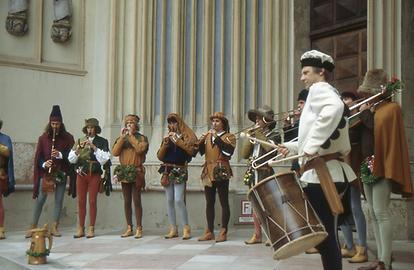


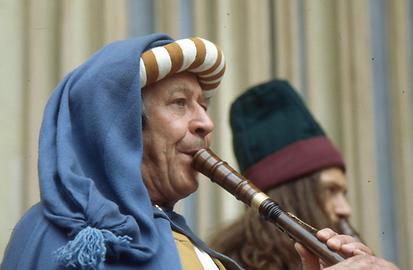
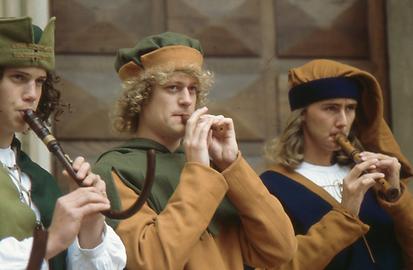
Imperial drummers and trumpet players are lining up and compete with musicians who have accompanied the royal bride from Poland and who show with pride the Polish eagle on their instruments.
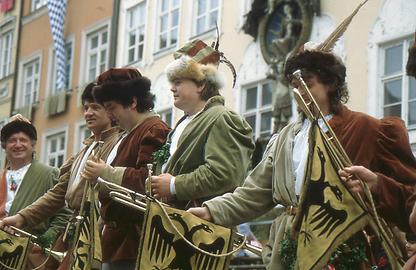
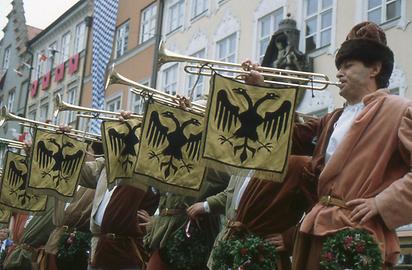
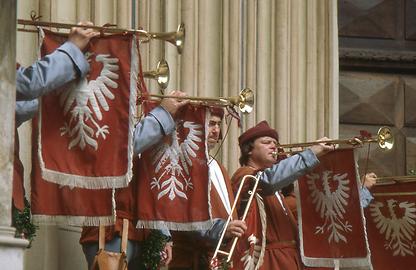
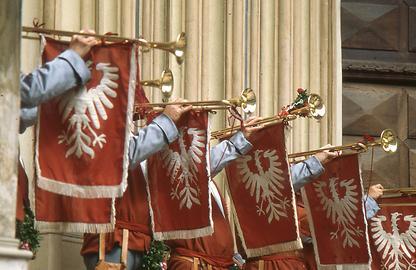
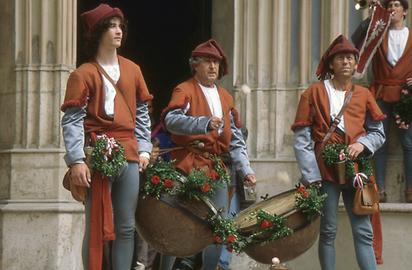
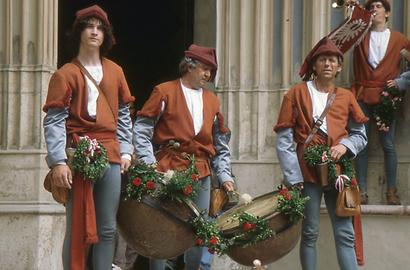
A strangely loaded horse-drawn carriage enters the city. A simple stage is quickly set up and the theatre play can start. Another pleasure! Amusing anecdotes in a simple language are presented. What are they all about? Of course, love and jealousy, horned husbands, sly and sexy women. Sounds of laughter end the play. The actors collect money and move on to the next corner.


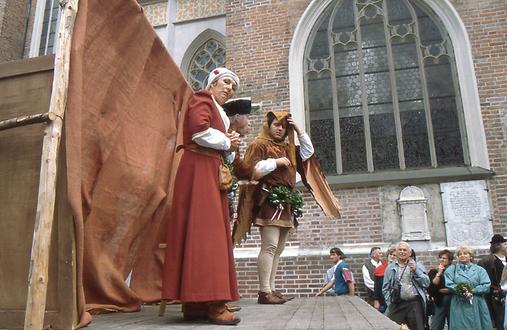
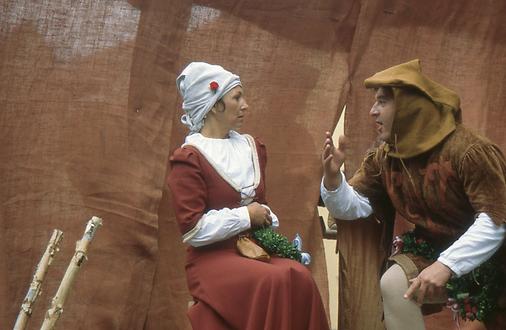
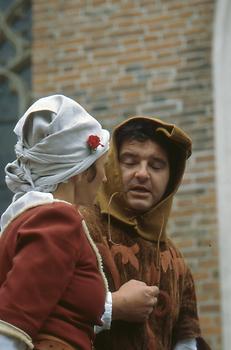
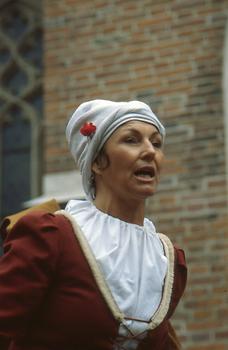
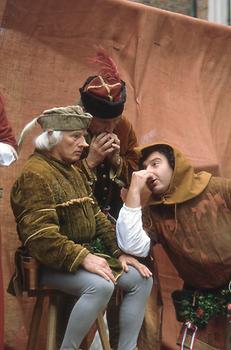
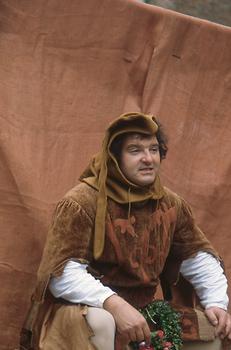
It is now Sunday afternoon and everything is waiting at the roadside, glancing out of the window, or looking down from the gallery. The most magnificent of all events is about to start. The bridal procession is introduced by music. Some of the musicians are already known from previous performances.
The colourful banners of the cities, belonging to the territory of the Duke George, the Rich, are following next. Here one sees the colourful world of coat of arms art at its zenith!
Councilmen, junkers and maidens announced by heralds on horseback are coming, divided into groups, but again and again also groups of people from the lower classes.
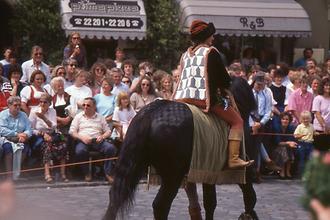
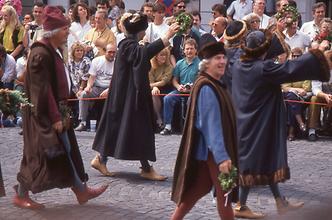

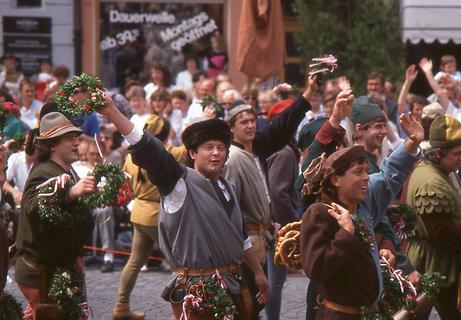
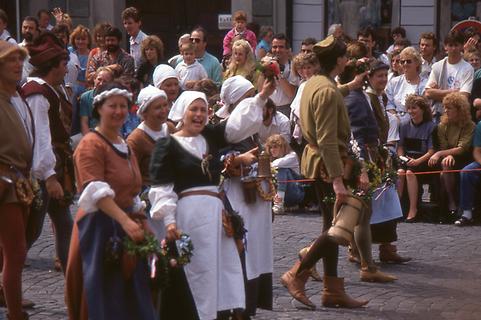
Crossbowmen indicat the strong possible defence of the city. They were considered as not knightly because of their dangerous weapons working at long range.
As in the past, the flag wavers with their skilful arts are particularly spectacular.
Even the Roman-German Emperor Frederick III with his son Maximilian I, the "Last Knight" and later Emperor as a Roman King, have come.
High, highest, and sovereign nobles and princes such as the Margrave of Brandenburg, Duke Ulrich of Wurttemberg, Ladislaus of Poland as the brother of the bride, the Margrave of Baden, and the forefront of the lower nobility participate in the procession.
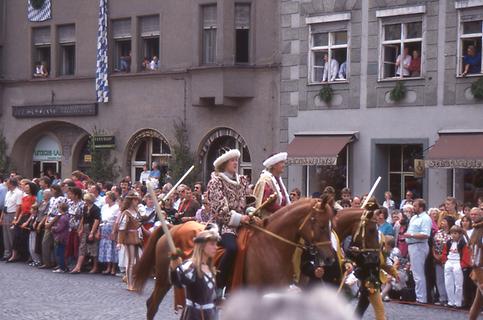

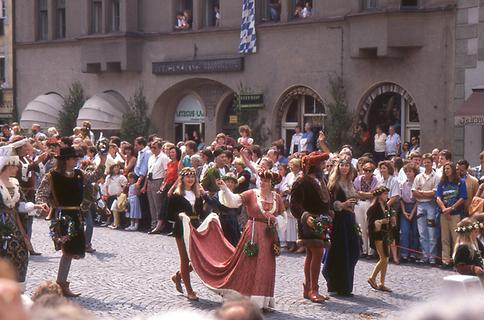


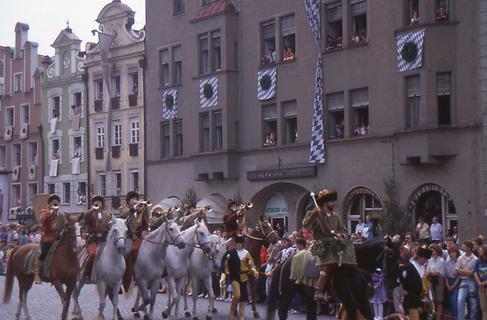
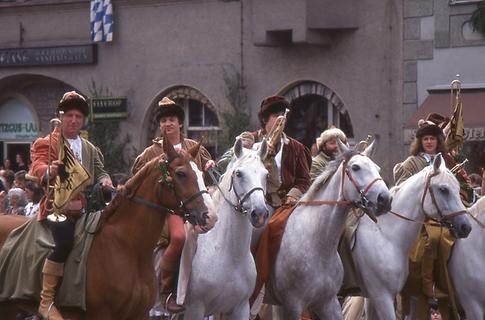

Duke Ludwig, the father of the bridegroom, participates in the procession with a sedan chair drawn by a horse. The chancellor is walking at his side. The court jester is allowed to ride. The wife of the Duke, Amelei of Saxony, follows in a state coach.
Even armed men in their iron clothes belong to the entourage of the Duke.
The bride, the main person of the procession, is announced by fanfares. With a crown on her head, she sits in a beautifully decorated chariot, and graciously greets on all sides. The twenty-year-old bridegroom, Duke George the Rich of Bavaria, is riding behind her.
Probably the bride looked similar to what one can see now, since she was picked to have a good likness with the lady depicted in the contemporary table painting mentioned. At that time the art of portrayal had already achieved a real-figurative greatness.
She comes with her own entourage. Everything what she brought with her from Poland is carried along, in big horse drawn carriages.
You can see, again and again, full carriages that served as transport means for the nobles or contained the dowry of the Polish bride.
The end of the procession is formed by a huge crowd of mercenaries with their long spears. Today they are not stained with blood, but adorned with flowers. They give an idea that the era of knights on their horses with their swords and lances had begun to end and other methods of conduct of war followed the Middle-Ages in military terms.
The question that arises is how expensive and enormous the probably most extensive German wedding in the Middle-Ages was. At that time, everything was recorded very precisely, so every detail is known. From abroad, about 10,000 invited guests had come. They had over 9163 horses which had to be taken care of and accommodated, as the oat allocation indicate.
The list of the food consumed is fascinating. They transformed into dishes: 323 oxen, 490 caves, 285 pigs, 684 suckling pigs, 1133 Hungarian sheep, 625 one-year-old sheep, 1537 lambs, 11,500 geese, 40,000 chickens, 194,345 eggs, 220 ton of lard, 68 flitches of bacon, 19 slices of salt, 1350 stock fish , 6 barrels of herrings, 14 centners of belugas, 5 tons of almonds, 5 centners of rice, 140 pounds of raisins, 730 pounds of figs, and tons of different flour. Not to forget the 500 pounds of sugar, 3 buckets of honey and more than 1000 pounds of exotic spices like saffron, pepper, ginger, cinnamon, nutmeg and cloves. They drank 900 buckets of luxury wines. 5616 buckets of table wines against the thirst accompanied the meals.
The expenses of food and drink for the guests is only a part of the big bill in which all expenses were summarized. The wedding celebration amounted to 60,766 Rhenish guilders and 73 pfennigs. According to a conversion from the 80s of the 20th century, the costs amounted to about DM 25 million, or about € 12 million. A considerable sum!
